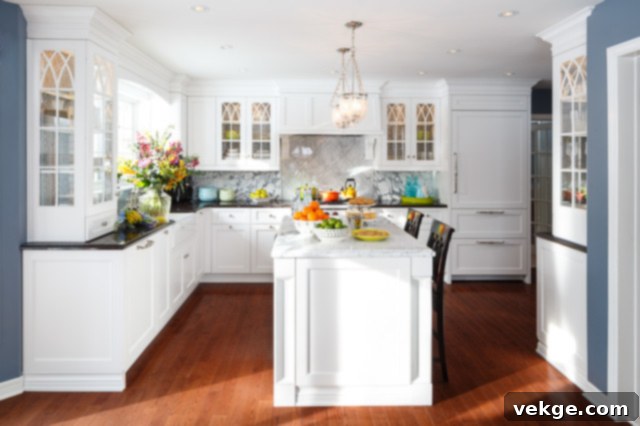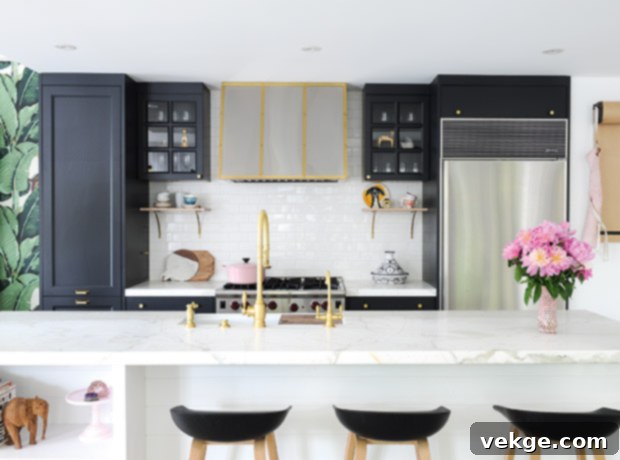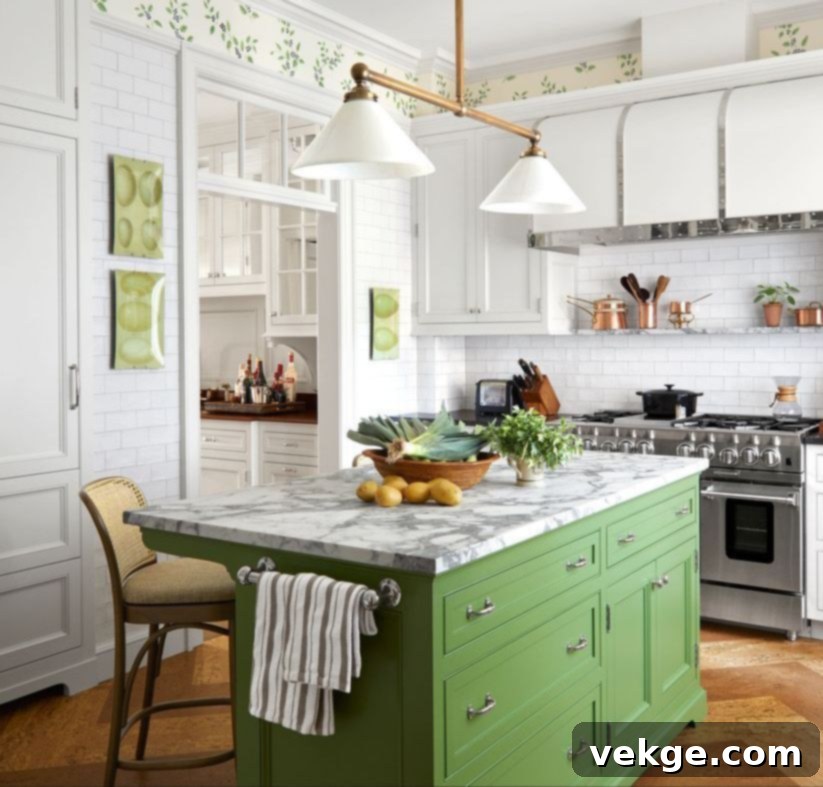Elevate Your Culinary Space: Top Contemporary Kitchen Paint Colors & Design Tips
The kitchen isn’t just a place for preparing meals; it’s the vibrant heart of the home where memories are made, stories are shared, and personal style truly shines. It’s a hub for creativity, connection, and daily life, making its ambiance and aesthetic incredibly important. A well-designed kitchen not only inspires culinary adventures but also serves as a comfortable, inviting space for family and friends to gather.
Transforming your kitchen’s look and feel can be as simple and impactful as changing its paint color. A fresh coat of paint can dramatically alter the mood, perceived size, and overall sophistication of your culinary domain. But with an endless spectrum of shades available, how do you pinpoint the perfect contemporary paint color that will make your kitchen both trendy and timeless?
Beyond the unique hue, it’s crucial to consider factors like the paint’s saturation, undertones, and glossiness. These elements collectively contribute to creating a kitchen that feels fresh, inviting, and effortlessly stylish. This comprehensive guide will explore the most trending kitchen paint colors, including timeless classics like white, soothing blues, and refreshing greens such as the popular Sherwin-Williams Evergreen Fog. We’ll also delve into the essential factors that matter most in achieving an elegant and inviting kitchen space.
Discovering the Best Paint Colors for Contemporary Kitchens
Choosing the right paint color sets the foundation for your kitchen’s aesthetic. Here are some top choices that perfectly blend modern trends with enduring appeal:
1. Classic White: The Epitome of Timeless Elegance

While trends may come and go, the unparalleled timelessness and versatility of classic white in the kitchen remain unmatched. White creates an instant sense of cleanliness, brightness, and spaciousness, making even smaller kitchens feel expansive and airy. Its reflective quality enhances both natural and artificial light, bathing the space in a luminous glow that feels fresh and invigorating.
A classic white kitchen transcends specific design styles, effortlessly adapting to elegant, modern, rustic, or even minimalist aesthetics. It provides a pristine backdrop that allows other kitchen elements—like natural wood cabinetry, colorful appliances, or unique backsplashes—to truly pop. White paint also pairs seamlessly with virtually any cabinet color, material, or style.
For a striking contrast that adds depth and sophistication, consider pairing classic white walls with navy blue cabinets. This combination evokes a crisp, nautical elegance. When selecting your white, opt for a nuanced shade that isn’t too stark or yellow. Look for a white with subtle warm or cool undertones that carry a hint of softness, preventing the space from feeling sterile and ensuring it feels welcoming and cozy.
2. Serene Blues: A Breath of Fresh Air
Blue is a perpetually popular choice for kitchens, celebrated for its soothing and refreshing qualities. It infuses the space with a sense of calmness and relaxation, reminiscent of the open sky or tranquil ocean waters. Psychologically, certain tones of blue are believed to stimulate appetite and creativity, while also being associated with cleanliness, freshness, and health—all desirable attributes for a kitchen environment.
The key to selecting the perfect blue for a contemporary kitchen lies in its moderation. Avoid overly dark or intensely bright shades, which can overwhelm the space. Instead, lean towards moderate blues that strike the right balance of saturation and brightness. Think muted blues, serene sky blues, sophisticated navy, or even grey-blues that offer a subtle pop of color without being too dominant.
When paired with crisp white cabinets, a moderate blue paint works magic, creating a classic, nautical, and incredibly fresh look. This combination is particularly effective in spaces aiming for a light, airy, and inviting atmosphere. Consider introducing metallic accents like brass or chrome to further elevate the modern appeal of a blue kitchen.
3. Invigorating Greens: Embracing Nature Indoors
Green tones offer the perfect hue for a lively and natural kitchen, cultivating an ambiance that promotes cheerfulness, energy, and an organic connection to the outdoors. It effortlessly brings a touch of nature and freshness into the culinary space, reflecting harmony, balance, and growth—much like the colors of plants, trees, and grass. The versatility of green means it can feel both grounding and uplifting.
For a contemporary kitchen, select greens that are neither too dull nor overly neon. The most appealing shades often carry a subtle pinch of yellow or blue undertone, making them more vibrant and serene. Popular choices include calming sage green, earthy olive, deep forest green, or a refreshing mint. Evergreen Fog, for instance, is a beautiful muted green-grey that exemplifies this balanced aesthetic.
To enhance the wholesome experience of a green kitchen, consider adorning your cabinets with a sophisticated shade of gray. The combination of green walls and gray cabinets creates a perfect balance, introducing neutral, modern, and incredibly refined elements into your kitchen design. Natural wood accents, brass hardware, and plenty of natural light will further amplify the organic charm of a green kitchen.
4. Blonde Wood + White + Black: A Striking Modern Symphony

For a truly meticulous and captivating kitchen design, the dynamic combination of blonde wood, crisp white, and bold black offers unparalleled results. This triad creates a sophisticated, modern, and highly inviting atmosphere when each color is strategically placed to maximize its impact:
- Blonde Wood: Integrate blonde wood into your flooring, open shelving, or even as accent pieces on island bases. Its light, warm tones add natural beauty, texture, and a grounding element to the space. Blonde wood creates a beautiful contrast with both white and black, injecting warmth and an organic touch that prevents the modern scheme from feeling cold.
- White: Use white generously on your kitchen ceiling and walls. This ensures the space feels clean, bright, and serene. White’s ability to reflect light magnifies the perceived size of the kitchen and elevates the beauty of other design elements. It provides a perfect canvas that highlights the natural grain of blonde wood and the sharp lines of black accents.
- Black: Incorporate black elements through your cabinetry, kitchen island, countertops, or appliances. Black introduces a sense of elegance, drama, and modern sophistication. It pairs exceptionally well with white and blonde wood, creating a striking visual contrast that defines spaces and adds a luxurious, contemporary edge. Think matte black hardware, sleek black stone countertops, or even a bold black accent wall for maximum impact.
This carefully balanced palette creates a harmonious yet powerful aesthetic, proving that a combination of different tones can yield a cohesive and stunning contemporary kitchen.
Essential Considerations When Choosing Contemporary Kitchen Paint Colors
Selecting the ideal paint color for your kitchen goes beyond mere aesthetics. Several practical and atmospheric factors should guide your decision to ensure a result that is both beautiful and functional:
Color and Tone: Crafting the Perfect Mood
The color and tone you select profoundly affect your kitchen’s mood, energy, and overall atmosphere, as colors are deeply associated with emotions. Before choosing, consider the desired feeling: warmth, coolness, freshness, or coziness? Examine the undertones of the paint—is it a cool gray with blue undertones, or a warm white with yellow hints? These subtle differences significantly impact how the color appears under various lighting conditions.
Furthermore, meticulously consider the existing colors of major kitchen elements such as cabinets, countertops, flooring, and appliances. The chosen paint color should either complement these elements, creating a harmonious and unified look, or provide a striking contrast that adds visual interest without clashing. Use color theory principles or create a mood board to visualize how all components will interact.
Paint Finish: Durability Meets Design
The paint’s finish is crucial in a high-traffic area like the kitchen, determining not only its brightness and aesthetic but also its durability and ease of cleaning. Different finishes reflect or absorb light differently, creating varied effects on the space. It’s imperative to test finishes and choose one that can withstand the demands of kitchen life:
- Matte/Flat: Offers a non-reflective, soft look, often used for ceilings. Not ideal for walls in high-traffic areas due to low durability and difficult cleaning.
- Eggshell/Satin: These are popular choices for kitchens. They offer a slight sheen, are more durable than flat, and are relatively easy to clean, making them suitable for walls that might encounter splatters.
- Semi-Gloss: Provides a noticeable sheen, is highly durable, and very easy to wipe clean. It’s an excellent choice for kitchen walls, trim, and especially cabinets, as it can withstand frequent cleaning and resist moisture.
- High-Gloss: The most reflective and durable finish, creating a mirror-like surface. While highly resistant to moisture and easy to clean, it highlights imperfections on surfaces, so meticulous preparation is required. Often used for accents or modern cabinetry.
For kitchen walls, especially near cooking areas, prioritize a finish that is stain, scratch, and moisture-resistant to ensure longevity and maintain a fresh appearance.
Lighting: Natural and Artificial Influence
The amount and type of light your kitchen receives will dramatically alter how paint colors appear. A color swatch might look perfect in the store, but entirely different in your home. Always test paint samples on your actual kitchen walls, observing them at different times of day—morning, afternoon, and evening—and under both natural light and your kitchen’s artificial lighting (warm vs. cool bulbs).
Kitchen Size and Layout: Maximizing Space and Flow
Lighter colors tend to make a kitchen feel larger and more open, while darker colors can create a cozier, more intimate atmosphere. Consider your kitchen’s layout: open-concept kitchens might benefit from a more cohesive color palette that flows into adjacent rooms, whereas a galley kitchen could be enhanced by lighter tones to prevent it from feeling cramped.
Tip: Embrace Neutrals for Balance and Longevity
While bold colors are exciting, neutral shades (grays, beiges, off-whites) are incredibly versatile and create a timeless appearance. Use them strategically to balance more vibrant colors, anchor a complex design theme, or provide a sophisticated base that allows you to easily update decor and accessories without repainting. Neutrals ensure your kitchen remains stylish for years to come.
Conclusion: Crafting Your Dream Kitchen with Color
Choosing the perfect contemporary paint color for your kitchen doesn’t have to be an overwhelming task. By carefully considering the aesthetic impact of classic whites, soothing blues, and invigorating greens, along with practical factors like paint finish, lighting, and existing elements, you’re well on your way to creating a space that is both beautiful and functional.
The right paint color, combined with appropriate glossiness and tone, can make an enormous difference in your kitchen’s overall look, mood, and long-term usability. While experimenting with different combinations can be a rewarding process, it can also be time-consuming. For a harmonious and impactful result, consider proven combinations like the modern elegance of blonde wood + black + white.
If you prefer a simpler two-tone approach, the crisp classic white + navy blue or the inviting blue + cream (off-white) combinations are truly magical. All these curated palettes have the potential to effortlessly transform your kitchen into a fresh, inviting, and truly contemporary space that reflects your unique style and enhances your daily life.
Frequently Asked Questions About Kitchen Paint Colors
How Do You Choose an Accent Wall for The Kitchen?
An accent wall is a single wall painted or treated differently from the others in a room, designed to draw attention and add visual interest. For a kitchen accent wall, ideal placements are often the wall opposite the main entrance, ensuring it’s seen immediately upon entering, or the wall directly behind your cooktop or primary focal point. Choose a color or texture that contrasts beautifully with your main kitchen palette, perhaps a deeper shade of your chosen color or a completely complementary hue, to create a striking statement without overwhelming the space.
How Do You Mix and Match Colors in The Kitchen?
Mixing and matching colors in the kitchen creates a unique and personalized contemporary look. A good starting point is to refer to the color wheel: choose colors that are complementary (opposite each other), analogous (next to each other), or monochromatic (different shades of the same color). A common guideline is the 60-30-10 rule: 60% of your kitchen should be your dominant color (e.g., walls), 30% a secondary color (e.g., cabinets or flooring), and 10% an accent color (e.g., decor or backsplash). Always use physical swatches to see how colors interact in your specific lighting conditions, and incorporate neutral tones to provide balance and prevent the space from feeling too busy.
How Do You Use Decor to Improve the Color Scheme of The Kitchen?
Decor elements like rugs, curtains, cushions, dinnerware, artwork, and lighting fixtures are powerful tools for enhancing and reinforcing your kitchen’s color scheme. To use them effectively, select accessories that either perfectly match or create a delightful contrast with your chosen palette. For instance, if you have a neutral kitchen, infuse pops of color through a vibrant rug or colorful ceramic dishes. Arrange decor in groups or layers to create visual depth and interest. Lighting, in particular, can be both functional and decorative, with fixtures that complement your color scheme and cast light that enhances the paint tones.
What are the Most Durable Paint Finishes for Kitchen Walls?
For kitchen walls, durability and ease of cleaning are paramount. Satin and semi-gloss finishes are generally considered the most durable and practical options. Satin offers a subtle sheen and is highly resistant to moisture and easy to wipe down, making it perfect for general wall areas. Semi-gloss provides a more noticeable shine, is even more robust, and stands up exceptionally well to frequent scrubbing, making it ideal for high-splatter zones like backsplashes or behind the stove. Avoid flat or matte finishes on kitchen walls, as they are porous and difficult to clean.
Should I Paint My Kitchen Cabinets or Walls First?
When undertaking a kitchen painting project, it’s generally recommended to paint your cabinets first, especially if you plan to repaint them a significantly different color. This allows you to protect your newly painted walls from drips or overspray during the more intricate cabinet painting process. Once the cabinets are complete and fully cured, you can then proceed to paint the walls, making it easier to cut in clean lines where the walls meet the cabinets without worrying about damaging the fresh cabinet paint. This sequence typically leads to a cleaner, more professional-looking finish.
